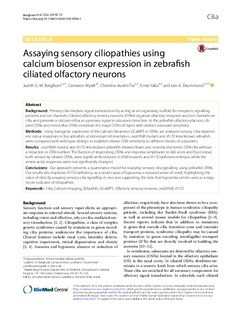| dc.contributor.author | Bergboer, JGM | |
| dc.contributor.author | Wyatt, Cameron | |
| dc.contributor.author | Austin-Tse, C | |
| dc.contributor.author | Yaksi, Emre | |
| dc.contributor.author | Drummond, IA | |
| dc.date.accessioned | 2019-09-19T07:09:11Z | |
| dc.date.available | 2019-09-19T07:09:11Z | |
| dc.date.created | 2019-01-18T13:05:43Z | |
| dc.date.issued | 2018 | |
| dc.identifier.issn | 2046-2530 | |
| dc.identifier.uri | http://hdl.handle.net/11250/2617519 | |
| dc.description.abstract | Background
Primary cilia mediate signal transduction by acting as an organizing scaffold for receptors, signalling proteins and ion channels. Ciliated olfactory sensory neurons (OSNs) organize olfactory receptors and ion channels on cilia and generate a calcium influx as a primary signal in odourant detection. In the zebrafish olfactory placode, ciliated OSNs and microvillus OSNs constitute the major OSN cell types with distinct odourant sensitivity.
Methods
Using transgenic expression of the calcium biosensor GCaMP5 in OSNs, we analysed sensory cilia-dependent odour responses in live zebrafish, at individual cell resolution. oval/ift88 mutant and ift172 knockdown zebrafish were compared with wild-type siblings to establish ciliated OSN sensitivity to different classes of odourants.
Results
oval/ift88 mutant and ift172 knockdown zebrafish showed fewer and severely shortened OSN cilia without a reduction in OSN number. The fraction of responding OSNs and response amplitudes to bile acids and food odour, both sensed by ciliated OSNs, were significantly reduced in ift88 mutants and ift172-deficient embryos, while the amino acids responses were not significantly changed.
Conclusions
Our approach presents a quantitative model for studying sensory cilia signalling using zebrafish OSNs. Our results also implicate ift172-deficiency as a novel cause of hyposmia, a reduced sense of smell, highlighting the value of directly assaying sensory cilia signalling in vivo and supporting the idea that hyposmia can be used as a diagnostic indicator of ciliopathies. | nb_NO |
| dc.language.iso | eng | nb_NO |
| dc.publisher | BMC (part of Springer Nature) | nb_NO |
| dc.rights | Navngivelse 4.0 Internasjonal | * |
| dc.rights.uri | http://creativecommons.org/licenses/by/4.0/deed.no | * |
| dc.title | "Assaying sensory ciliopathies using calcium biosensor expression in zebrafish ciliated olfactory neurons" | nb_NO |
| dc.type | Journal article | nb_NO |
| dc.type | Peer reviewed | nb_NO |
| dc.description.version | publishedVersion | nb_NO |
| dc.source.journal | Cilia | nb_NO |
| dc.identifier.doi | 10.1186/s13630-018-0056-1 | |
| dc.identifier.cristin | 1660240 | |
| dc.description.localcode | This article is distributed under the terms of the Creative Commons Attribution 4.0 International License (http://creativecommons.org/licenses/by/4.0/) | nb_NO |
| cristin.unitcode | 194,65,60,0 | |
| cristin.unitname | Kavliinstitutt for nevrovitenskap | |
| cristin.ispublished | true | |
| cristin.fulltext | original | |
| cristin.qualitycode | 1 | |

